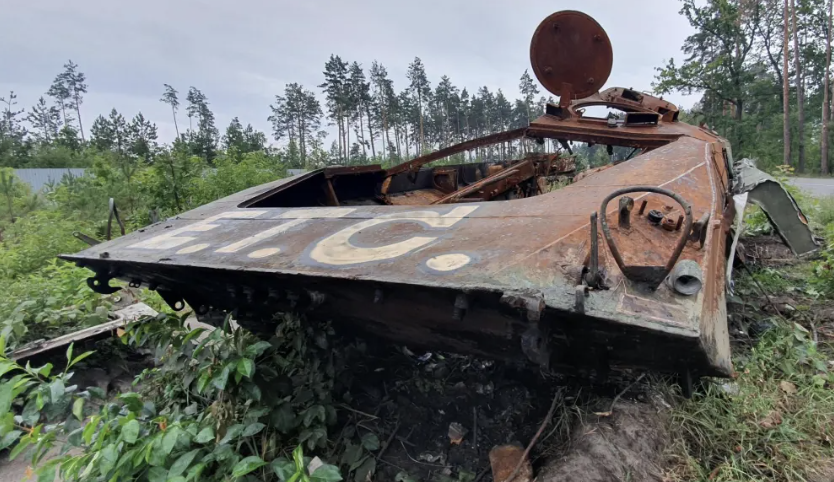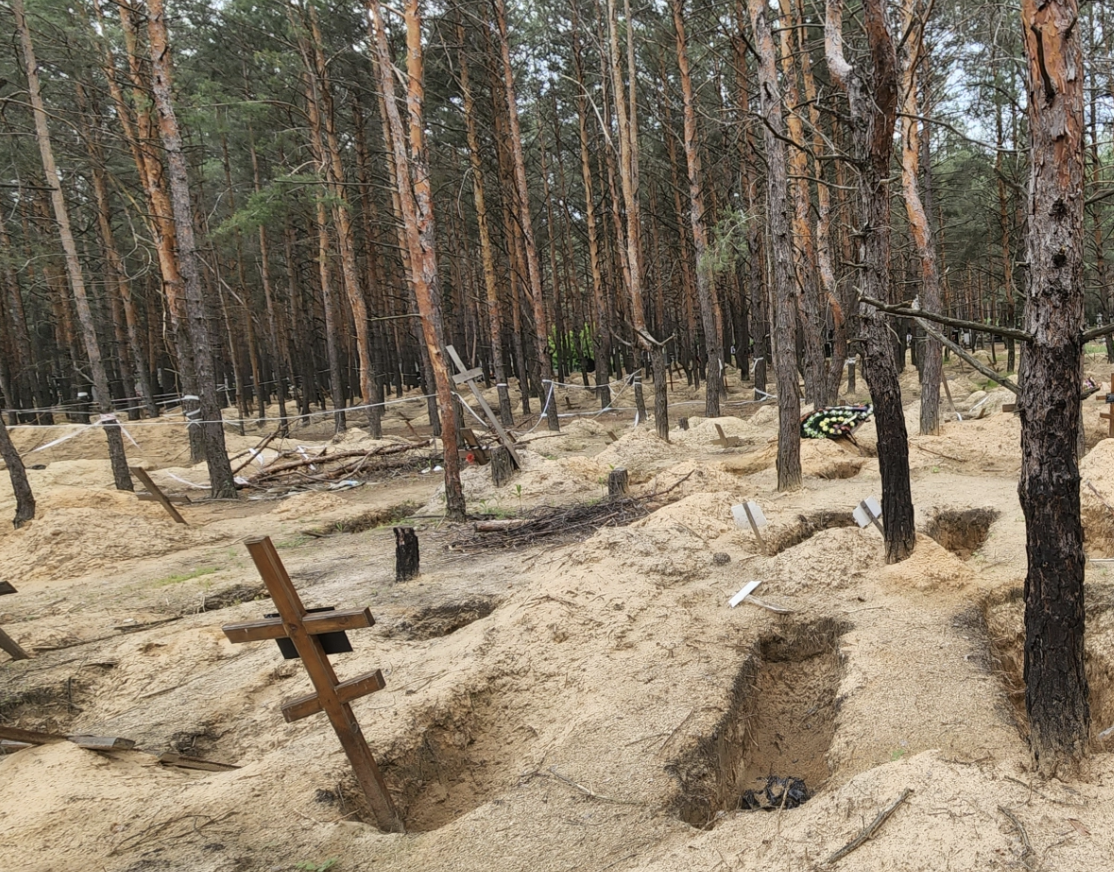News
How the War in Ukraine Will be Won: David Fells Goliath, and Then the Negotiating Table
Ukraine has outwardly changed over three phases following the Russian invasion on 24 February – hanging on against the Russian onslaught; getting organised and better armed; and now, on the cusp of a much-anticipated counter-offensive, confidently fighting back. It has proven resilient, innovative and adaptable, perhaps offering a model for enabling capacity through external cooperation. Russia, on the other hand, has shown that quantity, to use the old expression attributed to Stalin, does not have a quality all its own. While this war will end at the negotiating table, only the outcome of the military battle will get them there.

Deep in the Dorset countryside is a private British company refurbishing 50-year-old Sea King helicopters for use by the Ukrainian defence forces. Some of these warbirds saw service in the Falklands through Kosovo, Iraq and Afghanistan, though they have been given a complete overhaul before heading to the Ukrainian battlefield. There they are rendering sterling service, once more, in extracting the wounded and bringing in supplies.
This programme is a good example of how old equipment can be repurposed for minimal cost. It’s an illustration, too, of how the training of pilots and engineers must parallel any offer of equipment, one that has in this case been properly implemented. The procurement of more such Sea Kings can only, in this way, add considerably to Ukrainian capabilities.
But this programme is also an illustration of the Ukrainians getting only as much as donors are willing to provide rather than meeting their immediate needs. For comparatively little extra outlay, the Sea Kings could be fitted with stand-off Brimstone missiles, rather than go into combat zones unarmed.
Basis of support for Ukraine
Nick Reynolds of the Royal United Service Institute in London, which has excelled in its Ukrainian coverage, says that the performance of Kyiv’s armed forces to date shows that “it can win” with “consistent supply, standardisation, sufficient spare parts and maintenance and the type of equipment, including air defence and offence and electro-magnetic protection” that Ukraine needs. “We should not base our support of Ukraine on the basis of what we can give,” he says, “but rather what they need”, and nor “should we base our support for Ukraine on the result of each and every phase of this military campaign”.
Whatever the downsides of integrating multiple equipment types and managing complicated logistics and training schedules for disparate types, Western equipment has been critical in turning the tide on the battlefield in Kyiv’s favour. And yet, its technical prowess has reminded us that, while equipment is necessary, without the necessary motivation and skills it is never going to be enough. Afghanistan serves as a painful reminder of this old lesson.
Here the Ukrainians have, if nothing else, demonstrated their capability and capacity for success against a foe superior in numbers and once regarded as a superpower.
Difference between Ukraine and Russia on the ground
The manner in which older kit has been integrated with new systems and deployed is an illustration of the level of local motivation to repel the Russian invasion and, now, to ensure this never happens again.
The most notable feature of this war has been the fighting ability of the Ukrainians, set against the poor performance of the Russian forces.
The Russian forces have been depleted by heavy losses. Many have been in combat for more than a year. They are not especially well disciplined nor particularly well led. They are badly equipped in key areas such as communications and dependent on a strictly hierarchical command-and-control structure, consequently absent the type of small unit cohesion necessary to instil fighting confidence and ability, especially under the sort of military pressure that they are about to experience.
The surge in Ukrainian capacity is not just about Western equipment, but how they have deployed it, added to these capabilities, displayed initiative (and allowed their tactical level commanders to do so) and trained hard.
Being towed away from Kyiv on the back of a low-bed was a damaged MiG-29 fighter, apparently on its way to a decentralised repair facility. While the Ukrainians have been short of certain equipment, including modern aircraft capable of challenging fifth-generation Russian fighters and bombers like the Sukhoi Su-34 and 35, the way in which the Ukrainians have adapted civilian technologies has given them an edge, including meshing AI with intelligence.
Tank territory
But in other respects, it’s a war that looks similar to the trench combat of the Great War, the great rolling plains of Ukraine perfect tank territory too.
The delivery of newer Western tanks such as the M1 Abrams, Leopard 2 and British Challenger will make a difference, as has the deployment of long-range HIMARS and Storm Shadow missile systems, capable of striking deep-set Russian supply and command-and-control bases. So too has the use of Western 155mm artillery, more sophisticated and accurate than the Soviet-era equipment previously employed by Kyiv.
The usefulness of this equipment depends on the steady supply of Western ammunition and equipment, which might not continue in certain circumstances. One threat is political – especially the US appetite for continuing support for the Ukrainian cause, most likely only so long as the Democrats – or increasingly scarce pragmatic Republicans – remain in the White House.
Another threat is in the incremental assistance the West has so far preferred to supply to Ukraine, presumably out of fear that Kyiv will become too powerful and risk a radical response from Moscow or a change in tack from Beijing “if Putin was cornered and humiliated”, says Hryhoriy Nemria, the deputy chair of the foreign relations committee in the Ukrainian parliament.
Position of strength
Without certain weapon types, it will be hard to push the Russians out altogether. While the Russians have proven comparatively hapless on the battlefield, it is unrealistic – and possibly foolhardy – to expect or risk their complete disintegration. It’s certainly, however, a measure of disorganisation and destruction that Kyiv will have to achieve to end the conflict.
Kyiv’s aim for its much-anticipated offensive is for Ukraine to arrive at the negotiating table in a position of strength. After all, this table is where “every war ends”, the Ukrainian foreign minister Dmytro Kuleba says, “and our task is to bring Ukraine to the table in the strongest position possible”.
The sheer rate of consumption of shells in the conflict, at peak amounting to 20,000 daily by the Russians, represents a further threat. Given that the largest facility worldwide, in Scranton, produces 11,000 per month (though there are plans to increase this to 85,000 by 2028), there is a looming deficit in Nato stocks. Already, the US has given Ukraine “more than 1.5 million rounds of 155mm ammunition”, as part of Washington’s $38-billion in military assistance.
A final threat is in the continued ability of the Ukrainians to win on the battlefield, without which Western fatigue might set in, a trait that could be compounded by any failure on Kyiv’s part to develop a narrative beyond victimhood. Everyone loves a winner, not a whinger, and war is no different.
Countering disinformation
The battle of the narrative is ongoing, demanding considerable dedication of resources. Contending with the Russian version of the war, given Moscow’s comparative strengths of resources and news outlets including RT and Sputnik, is challenging. This demands countering disinformation, on which a Ukrainian government unit works full-time, and promoting a positive image of Ukraine based, says Mykhailo Podoliak, the head of the presidential office, on “its internal core strength, its rapid transformation, sincerity, and its ability to understand and manage complexity”. In this, he notes, “leadership allows us to have a global role and to be the subject”.
So far the Ukrainians continue to surprise and are alert to these challenges.
Ukrainian ingenuity can also be seen in their refurbishment of the vehicles left behind on the battlefield by Russians. Around the eastern city of Kharkiv, for example, the Russians abandoned nearly 400 armoured vehicles – now known, in Ukrainian humour and after the US World War 2 programme, as “Russian lend-lease”.
Cleaning up
Industriousness is present in other ways. About 4,000 homes in Kharkiv, Ukraine’s second-largest city just 30km from the Russian border, were destroyed in the early days of the war. This has mostly been cleaned up, though the city remains under artillery and missile fire and many of its shops and offices are boarded up.
The same is true for the areas around Kyiv, notably in the suburbs of Bucha, Irpin and Borodyanka. Today they are all being rebuilt, even though the bitter memories will remain, not least of the massacre of 458 civilians in Bucha, who were later buried in a pit behind the back of the local Orthodox church of Andrew the Apostle.
The eastern city of Izyum, too, has been scarred by the deaths of an estimated 1,000 civilians from an original pre-war population of 45,000. The city was liberated on 14 September. After liberation, a mass grave of 440 bodies was found in the woods to the north of the town, while an estimated 80% of housing was destroyed.
Today much of the town has been cleaned up. The secretary to the local municipality, Constantine Petrov, says a “horrible picture” greeted his team when they returned after the Russian retreat on 14 September. “Only a few houses on the outskirts had gas, and no one had electricity”. We chatted in the only municipal building left standing, new windows fitted where the old ones had been blown out by the constant shellfire that characterised the fortnight struggle for the town from February to March last year.
Similar conditions were created in Kharkiv.
The governor of the whole of the Kharkiv region, Oleh Synyehubov, puts the cost at 30,000 damaged and destroyed buildings, including 8,500 private households, 4,000 multi-story complexes, 800 educational establishments, 300 hospitals and clinics and 100 government buildings. He puts the number of dead at some 2,000 civilians, including 75 children. Synyehubov estimates the cost of destruction at around $15 billion “so far” since there are more than 20 towns in his oblast that continue to be shelled daily. He praises international benefactors who have come forward to assist, singling out Howard Buffet, who donated DNA kits to enable the identification of victims and has “rebuilt 15 bridges”’. He acknowledges, however, that salvation will come from inside, that “peace will only come about through a strong Ukraine and a strong military”.
“We have to count on our own strength, not that of international agreements,” Synyehubov says.
Hi-tech weaponry
It’s tempting too to be fascinated with the impact of hi-tech weaponry on the battlefield, including Russian hypersonic Kinzhal (or “danger”) missiles capable of striking targets at Mach 10, and the widespread use of Iranian Shahed drones (known locally as “scooters” because of the noise they make) as a terror weapon. The police station in Izyum was hit with one two days before we visited, putting the officers a bit on edge.
For military strategists, this war raises questions about how future armies might be structured and equipped. It stresses training, equipment, intelligence and the ability to quickly scale up in partnership with others. It also poses tough questions about the performance of the West in deterring Russia before the conflict, thus avoiding it altogether. The West’s abject performance in Afghanistan would have led the Russians to believe it was weak. Deterrence was further undermined by President Biden’s statement before the war that putting US troops on the table was “not on the table”. By removing this card, and by not saying clearly that the US would supply Ukraine with modern equipment as it has done, deterrence was undermined.
The more things change, the more they stay the same.

Wars are won by stamina, skill, logistics and leadership. Ukraine has great dollops of these, alongside its moral advantage: it is the victim of Russian aggression, the David who is delivering hammer blows to the Russian Goliath.
Ukrainians have excelled at organisation. The first days of the war were characterised by the chaos of refugee movements – more than five million Ukrainian women and children moved westwards, many to camps and homes elsewhere in Central and Western Europe. There were fuel and other shortages in the first few months, but quickly the Ukrainians got organised. Today, approaching 500 days into the war, Ukrainians are going about their life despite constant, daily Russian terror attacks against the cities. The cities are notable for the number of men now in uniform.
Kharkiv, for instance, which had been reduced to 500,000 people from its pre-war population of two million, is now back to the one million mark. The roads to the south, to Izyum and other towns are open, though the heavy security presence reminds one of the dangers. Electricity was restored in Izyum a week after the Russian withdrawal, while heating has been restored to more than 90 apartment blocks.
Already, quickly, the authorities are pursuing a stabilisation, normalisation and reconstruction agenda. In the Kharkiv oblast alone, 69,000 land mines have been lifted, roads are being repaired and electricity is being restored.
The upcoming offensive will be won – or lost – by the ability to achieve what military strategists describe as a “combined arms effect”.
This type of battle involves the close integration of artillery, air defence and offence and well-drilled, mobile ground forces. The Ukrainians now possess the surface-to-air missile cover to keep Russian aircraft and helicopters at bay; the ability to jam crude Russian comms; offensive drone (and some jet) capability; and with the delivery of Storm Shadow and HIMARS among other systems, the guided missile technology to hit Russian HQ and supply dumps far to the rear; proven short- and longer-range foreign and local anti-tank weapons; and sophisticated heavy tanks with the Leopard, Abrams, and Challenger as well as Western infantry fighting vehicles.
This approach also requires the integration of engineer units to clear obstacles, including the multi-layered minefields dug by the Russians. And then the organisation has to keep the offensive going, maintaining supply lines and operational tempo, something the Russians proved incapable of doing, in part because they chose February to invade and their convoys were strung out on paved roads, easy prey for Ukrainian anti-tank units and drones.
As David Petraeus, the retired US general, has put it, such a combined operation is “very complex … It’s a bit like a symphony. You have to have all of the different pieces play their part”.
He believes the Ukrainians now have this capability.
David fells Goliath...and then talk. How the war in Ukraine will be won from Brenthurst Foundation on Vimeo.
Path towards peace
Whatever happens, from a Ukrainian perspective, the war has to be finished quickly, before Russia manages to get its industry behind its war effort. Russia has so far done an exceptional job in shoring up its economy, even though it’s taken a hammering from Western sanctions. It seems now to be gearing itself for a long war, even though Putin will have to explain why even greater numbers of Russian boys are dying in this war, when the Ukrainians were supposed to have greeted them as liberators. Ukrainian estimates have the number of Russian dead at more than 207,000; Western estimates say that the overall number of casualties is around that number, including wounded. Bakhmut alone cost the Russian 17,000 dead and perhaps as many as five times that number wounded.
Either way, a large number of Russian boys are not coming home intact, if at all.
Those thinking of making peace in this neighbourhood will have to think not only of questions of international law, sovereignty, human rights and moral legitimacy in seeking compromise, but also putting in place the conditions that will prevent its recurrence. As Karina, who spent the six months of Russian occupation in hiding in Izyum, and who now runs a small restaurant in the town with her friend, pleads: “I just want peace, and silence.”
How the war ends will, critically, shape the manner of the peace.
This article originally appeared on the Daily Maverick
Photo: Greg Mills


